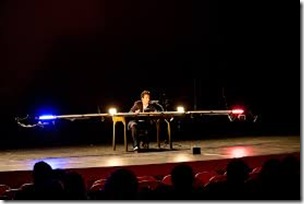17 Border Crossings or Around the World in 20 Years
After a three year lapse, the innovative company Lucidity Suitcase Intercontinental has returned to ArtsEmerson in Boston, this time with 17 Border Crossings. The earlier production Red Eye to Havre de Grace was a devised musical and dance piece, directed by Thaddeus Phillips, which focussed on trying to solve the mystery of Edgar Allen Poe’s death. Similar to Border Crossings and other works of Lucidity Suitcase Intercontinental, travel was an important element, although the plot was far more developed.
Lucidity Suitcase Intercontinental as its name suggests has no home. It is a travelling theatre that creates pieces which sometimes, as in the case of 17 Border Crossings, can be years in the making. It is based on trips that Thaddeus Phillips, the playwright and actor in this solo show, took over more than twenty years, starting in his youth. It is directed by Phillips’ wife and collaborator Tatiana Mallarino. The setting designed by Phillips is spare, consisting of a table, chair, microphone, radio and a long metal bar hung with lights that can be raised and lowered. In part, the bright lights serve to transition from one voyage to another. In one scene Phillips cleverly uses them to give the impression he is riding a bicycle. Phillips’ performance is reminiscent of Spaulding Gray’s monologues, but without the narcissistic intensity, while his set and David Todaro’s lighting recall Robert Lepage, but at a simpler level. Phillips audited Lepage’s work over a long period and appeared in his Miracle of Geometry. Lepage’s influence can also be seen in Phillip’s movement work.
The play gets off to an interesting start with Henry V’s St. Crispin’s Day speech, which relates to crossing borders. From there Phillips gives the history of Henry V’s role in the development of the passport, which is at the core of the play. In one scene, he is trying to get to Bali from Singapore with a friend carrying a Croatian passport. The friend is turned away because the list of countries at the Balinese border still contains Yugoslavia as if the civil war had never taken place and new countries carved out.
Crossing Borders is divided up into nonchronological scenes that tell their own story, although all concern entering another country. Phillips enacts the border guards who often seem set on keeping foreigners out, although he always ends up where he wants to be. He is very funny as he imitates their languages in an incomprehensible accent screaming at the top of his lungs. The two foreign languages that Phillips actually uses in the show are French and Spanish.
An early border crossing takes place in 1999 when he goes from Hungary into Serbia by train unaware of the danger involved during this time of war. He mentions a man throwing suitcases out of the train window as they are about to reach the border and waving at a car arriving to pick them up, without any further explanation. His naïveté does not leave him throughout the play. Towards the end he travels from Peru to Brazil where he goes into the bush to have a session with a shaman.
The lack of chronology contributes to confusion as the stories lose depth and time reality. Many of the scenes are whittled down to anecdotes. His trip from Egypt into Gaza describes the complexities of ordering Kentucky fried chicken if you live in Gaza. Missing, except for one reference to Syria and another to Mexico, is a connection to the present when immigrants and refugees are desperately searching for safety in a world where they are for the most part unwanted.
Production by Lucidity Suitcase Intercontinental.
Presented by ArtsEmerson
At Jackie Liebergott Black Box Theatre, Paramount Center, Boston
Created, designed, and performed by Thaddeus Phillips.
Directed by Tatiana Mallarino
Sound Design by Robert Kaplowitz
Lights by David Todaro
The production continues through April 29, 2017
